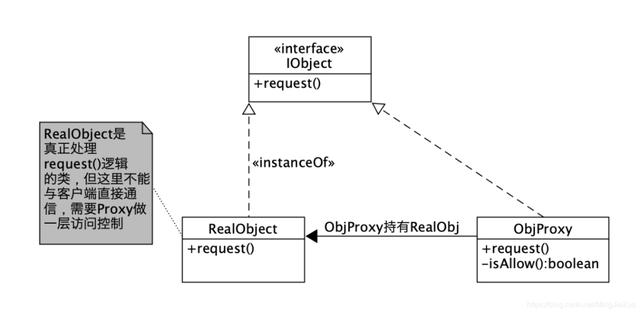

作者 | mjzuo
责编 | 王晓曼
出品 | CSDN 博客
在说动态代理之前,先来简单看下代理模式。
代理是最基本的设计模式之一。它能够插入一个用来替代“实际”对象的“代理”对象,来提供额外的或不同的操作。这些操作通常涉及与“实际”对象的通信,因此“代理”对象通常充当着中间人的角色。

代理模式
代理对象为“实际”对象提供一个替身或占位符以控制对这个“实际”对象的访问。被代理的对象可以是远程的对象,创建开销大的对象或需要安全控制的对象。来看下类图:

再来看下类图对应代码,这是 IObject 接口,真实对象 RealObj 和代理对象 ObjProxy 都实现此接口:
/**
* 为实际对象Tested和代理对象TestedProxy提供对外接口
*/
public interface IObject {
void request;
}
RealObj 是实际处理 request 逻辑的对象,但是出于设计的考量,需要对RealObj内部的方法调用进行控制访问。
public class RealObject implements IObject {
@Override
public void request {
// 模拟一些操作
}
}
ObjProxy 是 RealObj 的代理类,其同样实现了 IObject 接口,所以具有相同的对外方法。客户端与 RealObj 的所有交互,都必须通过 ObjProxy。
public class ObjProxy implements IObject {
IObject realT;
public ObjProxy(IObject t) {
realT = t;
}
@Override
public void request {
if (isAllow)
realT.request;
}
/**
* 模拟针对请求的校验判断
*/
private boolean isAllow {
return true;
}
}

番外
代理模式和装饰者模式不管是在类图,还是在代码实现上,几乎是一样的,但我们为何还要进行划分呢?其实学设计模式,不能拘泥于格式,不能死记形式,重要的是要理解模式背后的意图,意图只有一个,但实现的形式却可能多种多样。这也就是为何那么多变体依然属于xx设计模式的原因。
代理模式的意图是替代真正的对象以实现访问控制,而装饰者模式的意图是为对象加入额外的行为。

动态代理
JAVA 的动态代理可以动态的创建代理并动态的处理所代理方法的调用,在动态代理上所做的所以调用都会被重定向到单一的调用处理器上,它的工作是揭示调用的类型并确定相应的策略。类图见下:

还以上面的代码为例,这是对外的接口 IObject:
public interface IObject {
void request;
}
这是 InvocationHandler 的实现类,类图中 Proxy 的方法调用都会被系统传入此类,即 invoke 方法,而 ObjProxyHandler 又持有着 RealObject 实例,所以 ObjProxyHandler 是“真正”对 RealObject 对象进行访问控制的代理类。
public class ObjProxyHandler implements InvocationHandler {
IObject realT;
public ObjProxyHandler(IObject t) {
realT = t;
}
@Override
public Object invoke(Object proxy, Method method, Object[] args)
throws Throwable {
// request方法时,进行校验
if (method.getName.equals("request") && !isAllow)
return ;
return method.invoke(realT, args);
}
/**
* 模拟针对请求的校验判断
*/
private boolean isAllow {
return false;
}
}
RealObj 是实际处理 request 逻辑的对象。
public class RealObject implements IObject {
@Override
public void request {
// 模拟一些操作
}
}
动态代理的使用方法如下:我们通过 Proxy.newProxyInstance 静态方法来创建代理,其参数如下,一个类加载器、一个代理实现的接口列表、一个 InvocationHandler 的接口实现。
public void startTest {
IObject proxy = (IObject) Proxy.newProxyInstance(
IObject.class.getClassLoader,
new Class{IObject.class},
new ObjProxyHandler(new RealObject));
proxy.request; // ObjProxyHandler的invoke方法会被调用
}

Proxy源码
来看下Proxy 源码,当我们 newProxyInstance(…) 时,首先系统会进行判空处理,之后获取我们实际的 Proxy 代理类 Class 对象,再通过一个参数的构造方法生成我们的代理对象 p(p : 返回值),这里能看出来 p 是持有我们的对象 h 的。注意 cons.setAccessible(true) 表示,即使是 cl 是私有构造,也可以获得对象。源码见下:
public static Object newProxyInstance(ClassLoader loader,
Class<?>[] interfaces,
InvocationHandler h)
throws IllegalArgumentException
{
Objects.requireNon(h);
final Class<?> intfs = interfaces.clone;
/*
* Look up or generate the designated proxy class.
*/
Class<?> cl = getProxyClass0(loader, intfs);
...
final Constructor<?> cons = cl.getConstructor(constructorParams);
final InvocationHandler ih = h;
if (!Modifier.isPublic(cl.getModifiers)) {
cons.setAccessible(true);
// END Android-removed: Excluded AccessController.doPrivileged call.
}
return cons.newInstance(new Object[]{h});
...
}
其中 getProxyClass0(…) 是用来检查并获取实际代理对象的。首先会有一个65535的接口限制检测,随后从代理缓存 ProxyClassCache 中获取代理类,如果给定的接口不存在,则通过 ProxyClassFactory 新建。见下:
private static Class<?> getProxyClass0(ClassLoader loader,
Class<?>... interfaces) {
if (interfaces.length > 65535) {
throw new IllegalArgumentException("interface limit exceeded");
}
// If the proxy class defined by the given loader implementing
// the given interfaces exists, this will simply return the cached copy;
// otherwise, it will create the proxy class via the ProxyClassFactory
return proxyClassCache.get(loader, interfaces);
}
存放代理 Proxy.class 的缓存 proxyClassCache,是一个静态常量,所以在我们类加载时,其就已经被初始化完毕了。见下:
private static final WeakCache<ClassLoader, Class<?>, Class<?>> proxyClassCache = new WeakCache<>(new KeyFactory, new ProxyClassFactory);
Proxy 提供的getInvocationHandler(Object proxy)方法和 invoke(…) 方法很重要。分别为获取当前代理关联的调用处理器对象 InvocationHandler,并将当前Proxy方法调用调度给 InvocationHandler。
是不是与上面的代理思维很像,至于这两个方法何时被调用的,推测是写在了本地方法内,当我们调用 proxy.request 方法时(系统创建Proxy时,会自动 implements 用户传递的接口,可以为多个),系统就会调用 Proxy invoke 方法,随后 proxy 将方法调用传递给 InvocationHandler。
public static InvocationHandler getInvocationHandler(Object proxy)
throws IllegalArgumentException
{
/*
* Verify that the object is actually a proxy instance.
*/
if (!isProxyClass(proxy.getClass)) {
throw new IllegalArgumentException("not a proxy instance");
}
final Proxy p = (Proxy) proxy;
final InvocationHandler ih = p.h;
return ih;
}
// Android-added: Helper method invoke(Proxy, Method, Object[]) for ART native code.
private static Object invoke(Proxy proxy, Method method, Object[] args) throws Throwable {
InvocationHandler h = proxy.h;
return h.invoke(proxy, method, args);
}

ProxyClassFactory
重点是ProxyClassFactory 类,这里的逻辑不少,所以我将ProxyClassFactory 单独抽出来了。能看到,首先其会检测当前 interface 是否已被当前类加载器所加载。
Class<?> interfaceClass = ;
try {
interfaceClass = Class.forName(intf.getName, false, loader);
} catch (ClassNotFoundException e) {
}
if (interfaceClass != intf) {
throw new IllegalArgumentException(
intf + " is not visible from class loader");
}
之后会进行判断是否为接口。这也是我们说的第二个参数为何不能传基类或抽象类的原因。
if (!interfaceClass.isInterface) {
throw new IllegalArgumentException(
interfaceClass.getName + " is not an interface");
}
之后判断当前 interface 是否已经存在于缓存cache内了。
if (interfaceSet.put(interfaceClass, Boolean.TRUE) != ) {
throw new IllegalArgumentException(
"repeated interface: " + interfaceClass.getName);
}
检测非 public 修饰符的 interface 是否在是同一个包名,如果不是则抛出异常:
for (Class<?> intf : interfaces) {
int flags = intf.getModifiers;
if (!Modifier.isPublic(flags)) {
accessFlags = Modifier.FINAL;
String name = intf.getName;
int n = name.lastIndexOf('.');
String pkg = ((n == -1) ? "" : name.substring(0, n + 1));
if (proxyPkg == ) {
proxyPkg = pkg;
} else if (!pkg.equals(proxyPkg)) {
throw new IllegalArgumentException(
"non-public interfaces from different packages");
}
}
}
检验通过后,会 getMethods(…) 获取接口内的全部方法。
随后会对 methords 进行一个排序。具体的代码我就不贴了,排序规则是:如果方法相等(返回值和方法签名一样)或同是一个接口内方法,则当前顺序不变,如果两个方法所在的接口存在继承关系,则父类在前,子类在后。
之后 validateReturnTypes(…) 判断 methords 是否存在方法签名相同并且返回值类型也相同的methord,如果有则抛出异常。
接着通过
deduplicateAndGetExceptions(…) 方法,将 methords方法内的相同方法的父类方法剔除掉,并将 methord 保存在数组中。
转成一维数组和二维数组,Method methodsArray,Class< ? > exceptionsArray,随后给当前代理类命名:包名 + “$Proxy” + num。
最后调用系统提供的 native 方法 generateProxy(…) 。这是真正的代理类创建方法。感兴趣的可以查看下
java_lang_reflect_Proxy.cc源码和 class_linker.cc源码:
List<Method> methods = getMethods(interfaces);
Collections.sort(methods, ORDER_BY_SIGNATURE_AND_SUBTYPE);
validateReturnTypes(methods);
List<Class<?>> exceptions = deduplicateAndGetExceptions(methods);
Method methodsArray = methods.toArray(new Method[methods.size()]);
Class<?> exceptionsArray = exceptions.toArray(new Class<?>[exceptions.size()]);
/*
* Choose a name for the proxy class to generate.
*/
long num = nextUniqueNumber.getAndIncrement;
String proxyName = proxyPkg + proxyClassNamePrefix + num;
return generateProxy(proxyName, interfaces, loader, methodsArray,
exceptionsArray);
参考:Head First 设计模式:中国电力出版社
版权声明:本文为CSDN博主「mjzuo」的原创文章,遵循CC 4.0 BY-SA版权协议,转载请附上原文出处链接及本声明。
原文链接:
https://blog.csdn.net/mingjiezuo/article/details/105930334